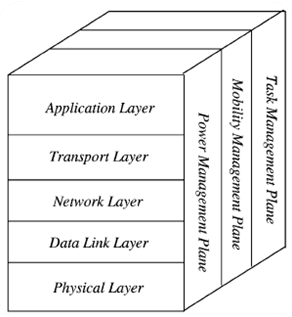Sensor network differ from the traditional ISO OSI Model of Communication Standards. Sensor nodes are not necessarily IP equipped and the seven layers of OSI model are in harmony with just three protocol stacks, namely, power management plane, mobility management plane and task management plane. This protocol stack performs functions of sensor network and combines power and routing awareness, integrates data with networking protocols, communicates power efficiently through the wireless medium, and promotes cooperative effort of sensor nodes.

The power management plane handles the power usages in the network for all the three domains as explained in chapter 4. The mobility management plane detects and registers the movement of sensor nodes so as to maintain the routes whenever necessary. The last plane ie the task management plane checks the balance in the network nodes and schedules the possible sensing job in task areas.
The communication range is very short in WSN which requires nodes to connect to their neighbors only hence the multihop routing exists. For sharing the common space and decreases interference among individual nodes for independence of routes, multihop communication is better than single hop in SN.
Infrastructure based & Ad-hoc SN
The infrastructure based SN is less flexible since it relies on the predeployed and structured topology, but provides better support of predictable performance guarantee (Hanzálek and Jurcik, 2010). The deterministic routing protocols and contention-free MAC protocols are generally deployed in infrastructure sensor network. The number of sensor nodes deployed in studying a phenomenon maybe in the order of hundreds or thousands. Depending on the application, the number may reach an extreme value of millions. The SN scalability must be addressed for the infrastructure requirement.
On the other hand ad-hoc or non-infrastructure sensor networks have good flexibility but with unpredictable performance. However, almost all SN are considered stationary once stable. This is achieved once the base station determines the cluster heads. Infrastructure is the base for working topology so that controlling and obtaining data from sensor nodes is easy. This is to say that even though the overall infrastructure of the network maybe fixed, some nodes may still be mobile while retaining the attributes to report to the server.

Pingback: Understanding LEACH Protocol in Wireless Sensor Networks
Pingback: Choosing the best Simulation or Emulation Software tool for Research
Please can you give LEACH matlab code password
Regards